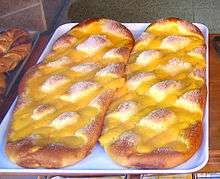Coca (pastry)
|
Sweet and savoury cocas | |
| Type | Pastry |
|---|---|
| Place of origin | Spain |
| Main ingredients |
Sweet dough: eggs, sugar Savoury dough: yeast, salt |
|
| |
| Part of a series on |
| Pizza |
|---|
.jpg) |
|
Pizza varieties
|
|
Cooking variations |
|
Pizza tools |
|
Related articles |



The coca (Catalan pronunciation: [ˈkokə], Western Catalan: [ˈkokɛ]) is a pastry typically made and consumed in territories of Catalan culture.[1][2][3][4]
The coca is just one way of preparing a dish traditionally made all around the Mediterranean.[5]
Etymology
The Catalan word coca—plural coques—comes from Dutch during the Carolingian Empire, and shares the same roots as the English "cake" and the German "kuchen".
Similarities
There are many diverse cocas, with four main varieties: sweet, savoury, closed and open. All of them use dough as the main ingredient, which is then decorated. This dough can be sweet or savoury. If it is sweet, eggs and sugar are added, and if it is savoury, yeast and salt. As regards the topping or filling, fish and vegetables are usual at the coast whilst inland they prefer fruit, nuts, cheese and meat.[6] Some cocas can be both sweet and savoury (typically mixing meat and fruit).
Types of coca
Coca is almost any kind of bread-based product. Its size can vary from 5 cm up to 1 metre. There are various presentations:
- the closed coca: a pie or pastry with filling.
- the open coca: the archetypical coca formed by a pastry base and a topping.
- the coca with a hole.
- the plain coca: a coca without any topping, because it is added during the course of the meal. Somewhat similar to Mexican tacos.
Popular varieties
Amongst the lengthy list of varieties, the most common are:
- Coca de recapte, a savoury coca with a variety of different ingredients, usually including sausage and vegetables, available generally.
- Coca de trempó, from Mallorca and the Balearics.
- Coca de San Joan, a sweet coca most typical of Catalonia, eaten on La revetlla de Sant Joan, St John's Eve.
- Coca de llanda, from the area around Valencia.
- Coca de xulla, often called coca de llardons, bearing bacon and other meat products, typical of any mountainous area.
The coca, festivities and popular culture
"Cocas are (...) strongly linked with our country’s traditions."[7] The coca is a dish common to rich and poor.[8] and a basic part of Catalan cuisine.
In Catalonia, the coca has a direct relationship with the festa or holiday.[9] It is typical to buy or prepare cocas during holidays, especially during Easter (Pasqua), Christmas (Nadal) and St John's Eve (la revetlla de Sant Joan). Some cocas even have the names of saints and they are eaten on that saint’s day (such as the Saint John’s Coca, Coca de Sant Joan). Nonetheless, many eat them without any religious or festive reason, especially if we consider that in places like Italy, this dish doesn’t carry any special significance. The Coca de Recapte obeys this logic exactly, since the "recapte" is a kind of picnic habitually taken out into the fields.
Similar recipes along the Mediterranean
Coca, being the Catalan variety of a Mediterranean dish, has local counterparts all over the Mediterranean, especially in its savoury kind. Apart from Italy,[10] other countries also have similar cakes, pies and pastries. Three examples are the Pissaladière from Provence, the Lahmacun from Turkey and the Bouchée à la Reine from France and Luxembourg, where it is one of the national dishes.[11] Similarly, sweet pies can be found all over Europe. The more specific King's cake (in Catalan, Tortell de Reis) is traditional in Occitania as well as in territories of Catalan culture as a part of the New Year holidays.
See also
- List of pastries
-
 Food portal
Food portal
References
- ↑ Eliana Thibaut i Comalada, Les Coques Catalanes, Proa, Barcelona 1995.
- ↑ Coca de recapte
- ↑ Coca d'albercoc
- ↑ Coca massegada (Spanish)
- ↑ Source: Eliana Thibaut i Comalada, Les Coques Catalanes, Proa, Barcelona 1995.
- ↑ Source: Eliana Thibaut i Comalada, pp20 Les Coques Catalanes, Proa, Barcelona 1995.
- ↑ Source: Eliana Thibaut i Comalada, pp17 Les Coques Catalanes, Proa, Barcelona 1995.
- ↑ "This is not a dish for the nobility, but rather one linked to popular traditions..." Source: Eliana Thibaut i Comalada, pp 17 Les Coques Catalanes, Proa, Barcelona 1995.
- ↑ "...we can assert that the coca is truly an example of popular cuisine associated with religious ritual..." Source: Eliana Thibaut i Comalada, pp19 Les Coques Catalanes, Proa, Barcelona 1995.
- ↑ "In Italy, (...) we have seen these cocas in bakeries and pizzerias, exactly the same as their valencian counterparts." Source: Martí Dominguez, Els Nostres Menjars (1978), quoted by Eliana Thibaut i Comalada, Les Coques Catalanes, Proa, Barcelona 1995.
- ↑ Fourney, Anne. "Le tour du Luxembourg en 12 plats" (in French). Luxembourger Wort. Retrieved 27 January 2016.
External links
| Wikimedia Commons has media related to Coques. |
- Fira de la Coca a Monistrol (Bages) (Catalan)